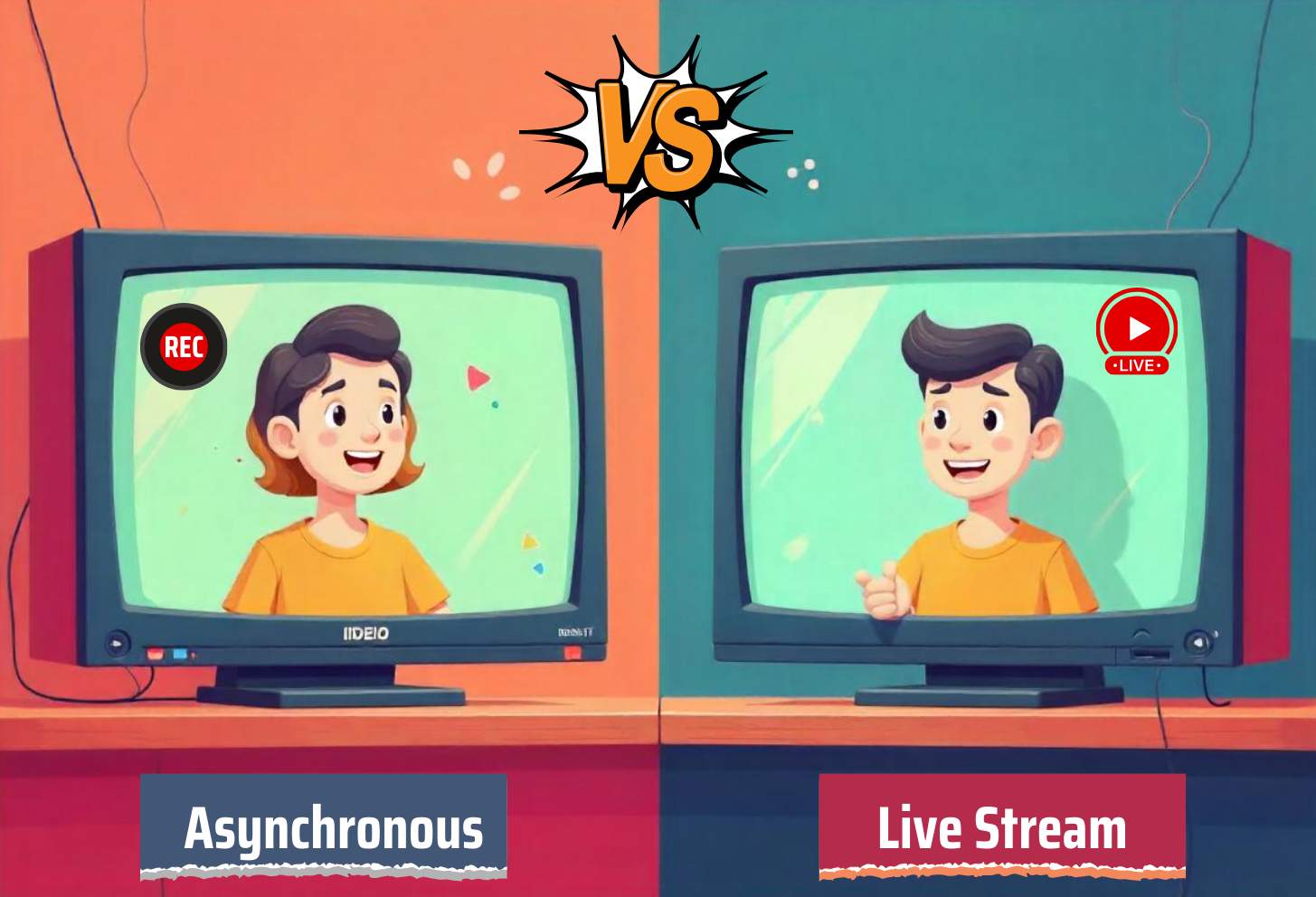The main difference between Asynchronous and Live Video lies in flexibility. Asynchronous video is pre-recorded content that viewers can watch anytime without time constraints.
Meanwhile, live video is real-time streaming content that requires everyone to watch online simultaneously.
This is just like the race of tortoise and hare.
Asynchronous video is like the tortoise. It gives you time to think and react whenever you want.
OTOH, live video is the speedy hare. It provides instant interaction that too real-time.
Both videos have strengths that brands can exploit. Then again, a wrong move can easily CUT into your brand image.
That’s why a showdown between Asynchronous and Live Video needs to roll.
That way, you can produce a strategy and reach people efficiently with both weapons. Result, lots of—
- Traffic
- View
- Engagement
- Conversion
- Sales
- Revenue
Asynchronous and Live Video
What is Asynchronous Video?
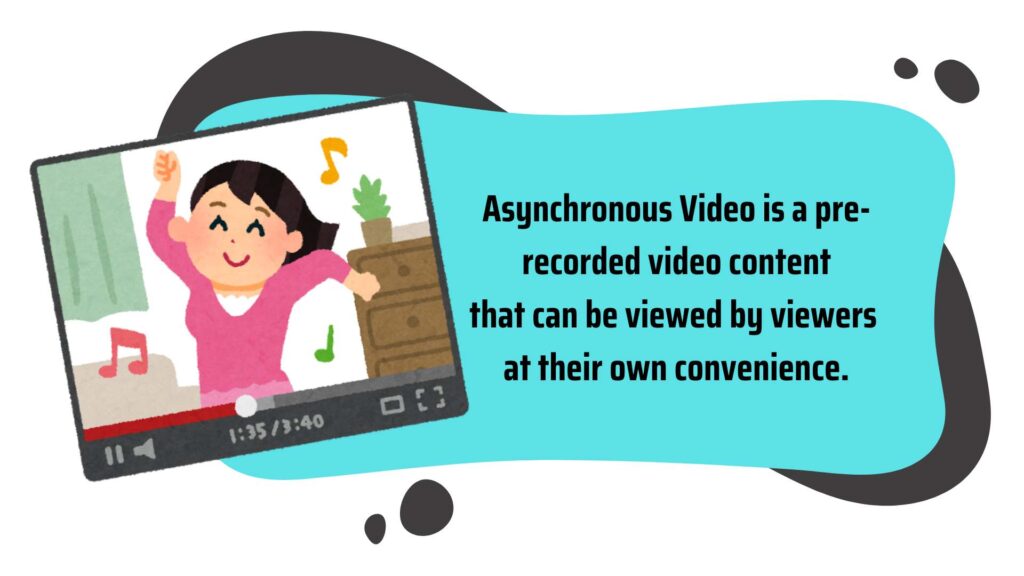
This takes things “offline”.
Asynchronous video is a pre-recorded content format that doesn’t happen in real-time.
Instead of live streaming, it lets viewers watch at their own convenience. Individuals can pause, rewind, fast-forward, or skip the videos whenever they want. So, they’re flexible and accessible.
Brands create and share such content for marketing, training, customer support, and storytelling. It allows brands to deliver consistent messages and reach broader audiences.
The videos also help save time since you can use the same content again and again.
Examples
This sums up the asynchronous video meaning.
It’s basically an efficient way for brands to engage audiences without time constraints.
What is a Live Video

Real-time streaming.
Live video is a real-time video broadcast that happens as viewers watch online on the spot.
It’s a streaming format that lets them watch events, conversations, or activities instantly. There’s no editing or delays. Instead, individuals check out and share experiences as they unfold in real-time.
Brands use live videos to connect with those audiences directly. It’s because such content creates a sense of urgency and excitement that brings immediate engagement.
Viewers can ask questions online and share comments while the video is ongoing. This makes the format more personal and interactive.
The content is popular in different industries since brands use them for: product launches, Q&A sessions, and events.
Examples
- Webinars
- Live customer support
- Virtual events
- Instagram Live
- Facebook Live
- YouTube Live
Such a spontaneous nature adds authenticity. It helps you as brands build trust and loyalty.
Live videos can be a powerful tool to show your candid personality and strengthen relationships.
Key Differences Between Asynchronous and Live Video
| Factor | Asynchronous | Live |
| Delivery | Pre-recorded | Broadcast in real-time |
| Communication | One-way, self-paced | Two-way on the spot |
| Engagement | Continuous (comments, emails) | Immediate (live chat, reactions) |
| Convenience | Viewable anytime | Presence required |
| Flexibility | Watch on-demand | Scheduled timing |
| Editing | Post-production required | No edits |
| Audience reach | Easier scalability | Depends on the time slot |
| Content effect longevity | Long-lasting | Short-lived |
| Example | Training, product videos | Webinars, live events |
Benefits and Drawbacks of Each Video Format
Advantages of Asynchronous Video
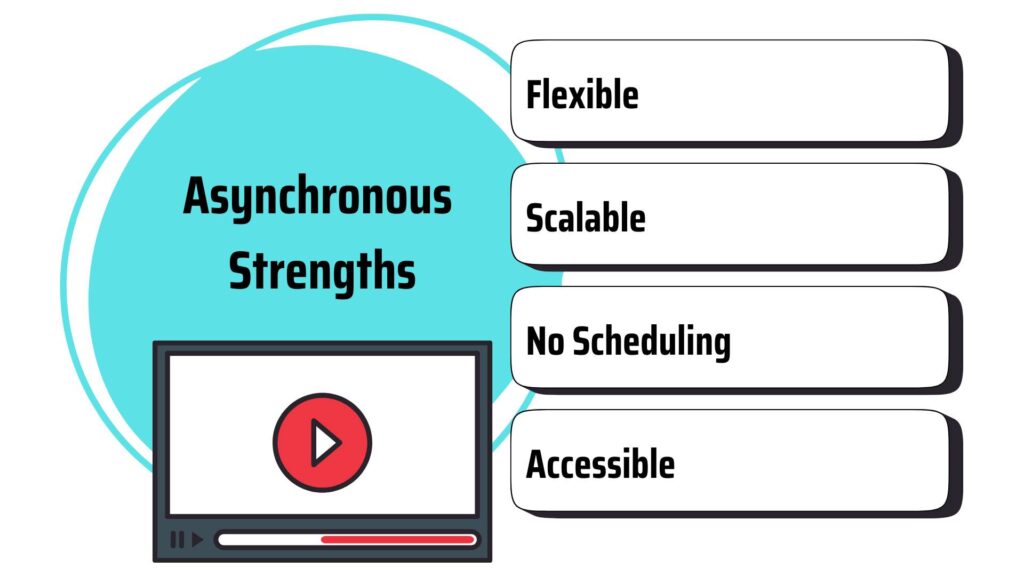
More Flexibility
Asynchronous video means viewers can check it out anytime.
This is super important because everyone has a different schedule, and they’d like to watch something when it’s convenient for them.
The pre-recorded thing gives that freedom to your target group. You don’t even have to stress about time zones.
Think about a training video or product launch. You shared them across social media. Your audience can watch or rewatch them whenever they want.
As per a survey,
“92% of participants rewatched content from the past month.” This shows the video’s flexibility for repeated engagement.
Scalability
Asynchronous is highly scalable.
You can create one video and use it again and again. It works like a resource that just keeps on giving.
That’s the power of repurposed videos.
Around 94% of 48 marketers repurpose content for different channels— a survey by Referral Rock says.
Let’s say, you have created a product launch video. The content can be used in different ways for future use. You can take highlights from the video and create social media posts, teasers, or email marketing content.
This helps you maintain brand consistency. You can also maximize the value of your original video across different channels.
Reduced Scheduling Conflicts
No need to align multiple time zones.
Finding time to host a live session can be tricky for businesses with a global audience. Asynchronous video throws away that scheduling hassle.
Customers from different spots worldwide can engage with the brand’s content at their own pace. This ensures no one misses out on important info or news.
Whether someone is in Chicago or in Sydney, everyone can check out the video anytime.
Brands like Apple, Google, and Microsoft have global audiences. So, such content works as a powerful tool for them.
Better Accessibility
Convenience of media controls.
Asynchronous videos are super accessible. Your viewers can pause, rewind, or adjust the playback speed to understand the brand content.
This is particularly beneficial for users needing extra time to digest the content. Those who prefer to take notes also benefit.
Such flexibility makes sure everyone enjoys the video, no matter the situation.
For instance, a tech-based product demo can be a little difficult to understand from the get-go. Individuals can pause and rewind the demonstration to grasp it.
Disadvantages of Asynchronous Video
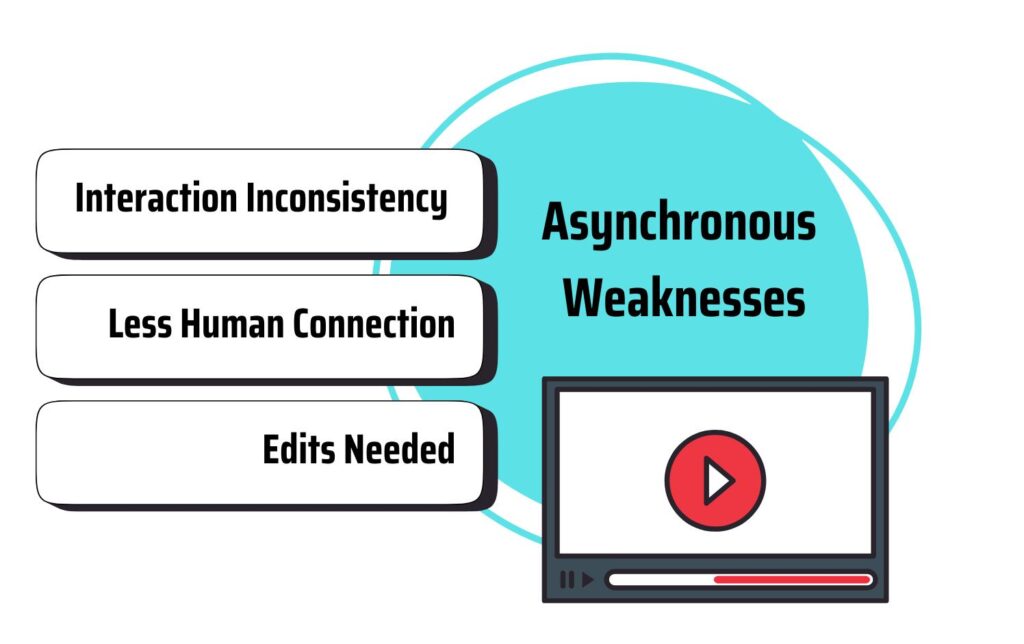
Inconsistent Interaction
One downside? There’s no immediate communication. If viewers have questions while they watch, they can’t get answers right away.
That’s the deal with asynchronous video. Yes, the audience can interact with it instantly but it’s one way. They may have to wait to get a response from the brands. Sometimes, they may not get it at all.
So, the interaction is inconsistent. There’s no instant feedback or discussion like you’d have in real life.
This can be frustrating for people who appreciate a conversational approach.
Less Human Connection
Asynchronous videos can feel a little distant or robotic. There’s no chance for the speaker to feed off viewers’ energy.
Without live interaction, it may become difficult for businesses to engage with people emotionally.
For example—
A pre-recorded training video can seem dry when compared to a live session where the instructor engages with the team.
Such disconnect can make it harder to build personal connections with viewers.
Editing Required
You know how sometimes when you post a picture of nature on social media, you edit it to enhance its beauty?
It’s the same with pre-recorded videos.
Creating polished content often involves lots of editing. Businesses need to ensure the final product is high-quality and error-free. This can be time-consuming.
For instance—
- An explainer video takes the most time in post-production.
So, brands looking to maintain a professional image should be ready to invest time and resources in editing each video.
Mistakes made during the recording need fixes in post-production. It can delay delivery.
Advantages of Live Video
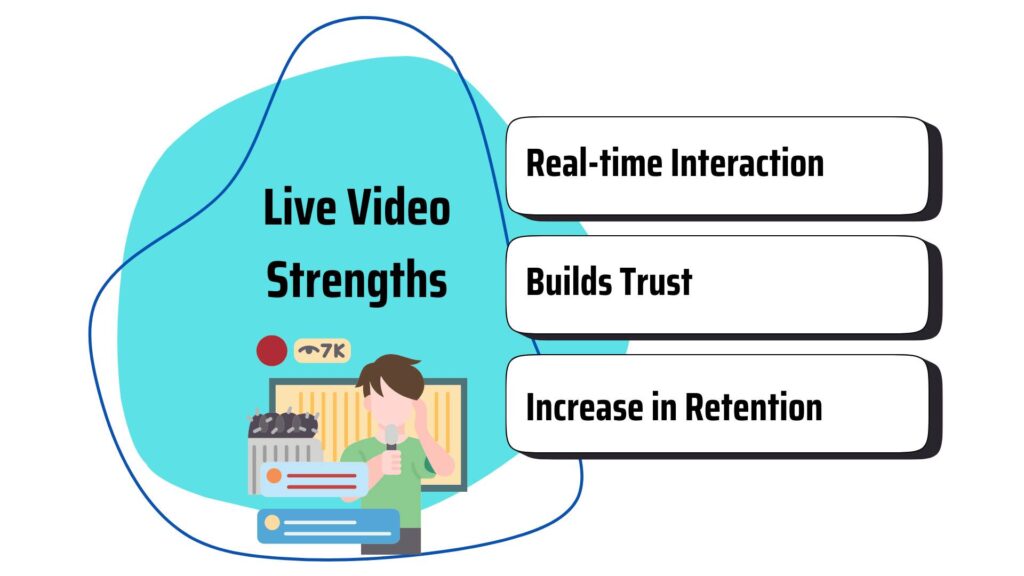
Real-time Engagement
Live video brings a whole new level of energy.
You’re there in the moment— relishing the vibe. Brands use this spirit to connect with their viewers.
When someone hosts live sessions, they encourage instant discussions and Q&A. Viewers can type questions and the host can respond on the spot. So, they’re getting immediate answers.
This creates a buzz and builds excitement.
Take a webinar for instance. Viewers can interact directly with the product as it’s being presented.
They feel more involved and invested. And this leads to more engagement and interest.
As per a survey by Livestream—
“80% would rather watch live video from a brand than read a blog.”
Builds Trust
Authenticity is the real deal.
Live videos allow businesses to show their authenticity.
When viewers see someone speaking or handling questions live, they get to witness their personality and spontaneity. It’s all candid and raw.
This transparency helps build trust and loyalty.
Good brands like to be transparent and live videos are an efficient way to show that–
- They stand by their products and
- They’re committed to their people
A 2021 survey mentions that—
Over 80% of consumers prefer buying from brands they trust.
Live video helps with that.
Boosts Audience Retention
Live videos keep people hooked.
Viewers feel more connected and attached through interactive elements like Q&As, polls, and live chats. They’re less likely to tune out when they participate.
The more consistent interaction means more audience engagement.
Such engagement results in longer watch time—- making the overall experience more valuable.
Disadvantages of Live Video
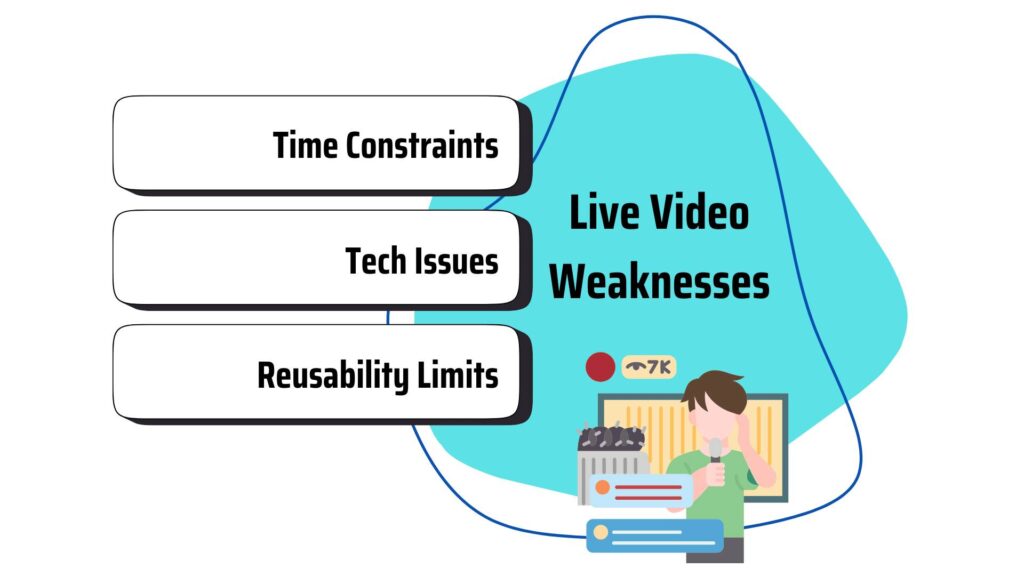
Time-sensitive
The big catch with live video? Timing!
Everyone needs to be available and present at the same moment online. This can be a real challenge, particularly for global audiences.
For instance–
If a brand goes live at 8 PM EST, many viewers in different time zones may not be able to watch it like—
1 AM GMT, 2 AM CET, 3 AM EET, and 6:30 AM IST— because it’s quite late and most viewers may be asleep.
If they miss the session, they may miss out entirely.
Tech Glitches
Tech can be incredible. And live video is no exception.
A weak internet connection, software glitches, or equipment failures can disrupt the experience.
This makes the content frustrating for the audience and embarrassing for the brand.
If anything goes wrong— like poor audio or video quality, it can deter viewers from getting back to the video.
Limited Reusability
Once a live event is done, its impact often fades.
Sure, you as brands can record, save, and upload it across social media. However, the spontaneity and energy of the live event may not translate well when watched later.
For example—
A lively Q&A session loses its appeal when archived. This can affect the brand’s ability to generate interest in the recorded version.
When to Use Asynchronous vs. Live Video?
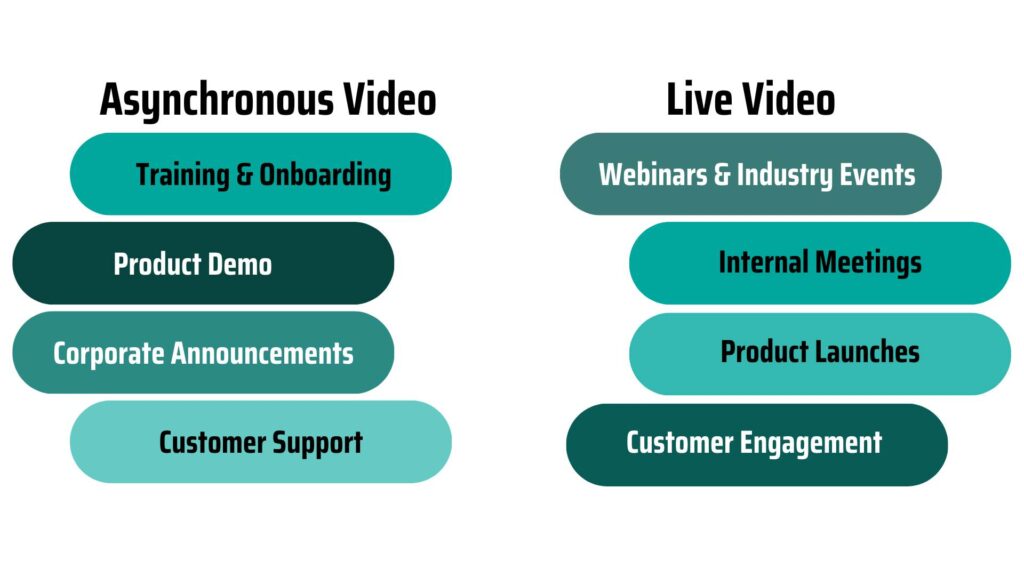
Best Use Cases for Asynchronous Video
Employee Training and Onboarding
Asynchronous videos are just right for training new hires.
Brands can create pre-recorded training modules that employees can watch anytime. This flexibility lets them learn at their own pace.
It reduces the stress of catching up in live sessions.
This is more common in brands like Salesforce and Acorns.
Product Demonstrations
Brands with products make the most of asynchronous videos.
Two great examples are software tutorials or how-to content. Platforms like Loom allow you to create such engaging, step-by-step content.
Customers can revisit these demos anytime they need. They can use media control to understand how your product works and how to it effectively.
Corporate Announcements
Communicating important messages from the CEO can be difficult for global brands.
Asynchronous videos allow these corporate announcements to reach employees and target groups worldwide. People don’t even have to be present at the same time.
The main goal is to inform people. It doesn’t matter when and where they receive the information.
Customer Support
Companies also use asynchronous video for customer support.
Instead of answering repetitive FAQs through long calls or emails, brands create short FAQ videos and address common issues.
Such videos save time for customers and support teams while giving clear, visual answers.
Best Use Cases for Live Video
Webinars and Industry Events
Live video shines in interactive formats like webinars.
Brands can host real-time Q&A sesh where viewers can ask questions and get answers instantly.
Such engagement helps build authority and trust in your brand.
Moreover, the audience also gets to see the candid moments of real people involved in the brand. This raw side shows transparency and makes you reliable among people.
Internal Meetings
Live videos are also effective for team meetings.
Brands can use this format for weekly check-ins to keep everyone aligned. It helps remote teams feel connected.
Plus, it allows for open discussion about projects, progress, challenges, and successes.
Product Launches and Sales Presentations
You can unveil new products or features in real time through live events.
With this, brands can shoot up excitement and buzz. This allows viewers to engage directly during the stream.
This immediacy helps increase engagement and conversion.
For instance–
A company may go live and showcase its latest gadget at the event. Individuals online can see it in action and ask questions instantly.
Customer Engagement
Live social media allows brands to connect directly with their customers.
This mostly happens through Q&A. Fans can ask questions and get live feedback and opinions directly.
This two-way communication—
- Strengthens customer loyalty and
- Enhances brand image
Best Tools and Platforms for Asynchronous & Live Video
Top Asynchronous Video Tools
| Platform | Features | Best For |
| Loom | Screen recording, easy sharing | Remote teams, async feedback, product demos |
| GoReact | Video-based coaching, feedback | Training, education |
| Vimeo | High-quality video hosting | Marketing, corporate videos |
| Youtube | High-quality video | Brand storytelling, explainer |
Top Live Video Tools
| Platform | Features | Best For |
| Zoom | Webinar hosting, live meetings | Corporate meetings, training |
| Facebook Live | Real-time streaming, audience engagement | Marketing, brand awareness |
| YouTube Live | Live broadcasting, monetization options | Webinars, large-scale events |
| Instagram Live | Real-time streaming, specific audience engagement | Social media engagement, brand storytelling |
Performance & Engagement Metrics: Measuring Success
How to Measure the Success of Asynchronous Video
- Watch time & completion rate: Are people finishing the video?
- Engagement metrics: Comments, shares, and likes.
- SEO performance: Video ranking on Google and YouTube.
How to Measure the Success of Live Video
- Live attendance rate: How many people join?
- Interaction level: Live chat engagement, polls, Q&A participation.
- Replay views: Are people watching the recording?
SEO & Marketing Implications: Asynchronous vs. Live Video
How Asynchronous Videos Improve SEO
YouTube & Google Indexing
Asynchronous videos work well on platforms like YouTube, where they can be indexed for relevant keywords.
When businesses make well-optimized videos, they have better chances of showing up in searches.
By that, we mean content— that has the right keyword in titles and descriptions.
Long-Term Traffic
Asynchronous videos can keep attracting views long after they’re uploaded. This is particularly true for the ones that cover evergreen, timeless topics.
For instance–
Tutorials that help solve common issues can bring in continuous traffic and leads for a long time.
Repurposing Content
Brands can turn asynchronous videos into different content types. For example– blog articles, social media clips, infographics, or teasers.
This helps you get more value from the original video and boosts SEO as well.
How Live Videos Impact SEO & Engagement
Boosts Real-time Engagement
Live videos often grab attention right away.
When brands go live on platforms like Facebook, it usually sends notifications to followers. This increases visibility and engagement.
Higher engagement during live sessions like comments and shares can improve search engine rank.
That’s why algorithms favor live content.
Event-Based Traction
Live events can create a thrill around a brand. It can draw traffic to its website or social media pages.
Businesses can build interest and get more people to join by promoting live sessions beforehand.
This can lead to more followers. And more followers mean more interaction during and after the event— if the recorded content is shared.
Short Lifespan with Replay Value
Once the moment is over, interest can wane quickly.
However, they can still be useful after the event. Brands can save and share these videos for people to watch later.
Then again, replays usually get less engagement than the live versions. As a result, traffic drops.
So, brands should promote the recorded content to keep it visible.
Choosing the Right Strategy for Your Business
Small Businesses
Asynchronous videos are great for training and social media clips. They’ll save you time and resources.
Large Enterprises
A hybrid approach works best. Use asynchronous videos for documentation and training while going live for more engagement.
E-commerce & Marketing
Consider live videos for sales events.
Showcasing products live can drive immediate purchases. Meanwhile, asynchronous content can serve as product tutorials for long-term traffic.
Remote Teams & HR
Asynchronous videos for onboarding can make the process smoother. This allows new hires to learn at their own pace.
On the other hand, live meetings can keep everyone aligned on goals.
Frequently Asked Questions (FAQS)
Asynchronous video is pre-recorded content– allowing viewers to watch it anytime that works for them.
The difference lies in the flexibility. Asynchronous content allows for flexible viewing whereas synchronous video requires everyone to be available at the same time.
A Zoom call is synchronous. Because participants need to join in real-time at the same time.
Asynchronous video allows team members to learn and access information at their convenience. This promotes independence and flexibility.
Yes. You can record live videos and share them later as on-demand content.
Live video often engages audiences more as it offers real-time interaction immediately.
Asynchronous video can come in the form of tutorials, product demos, explainers, and brand stories. Businesses can use and share them across different platforms like Facebook and YouTube for marketing.
Yes. There are many. For example– education and events. These industries thrive on live video.
Yes. Live videos can attract real-time engagement. This can boost its visibility in algorithms as well as SEO rankings more than the asynchronous one.
Loom, GoReact, Vimeo, YouTube— these are some popular platforms for creating asynchronous video content.

Founder at LocalEyes Video Production | Inc. 5000 CEO | Emmy Award Winning Producer

